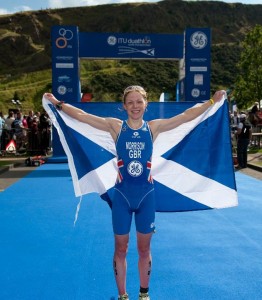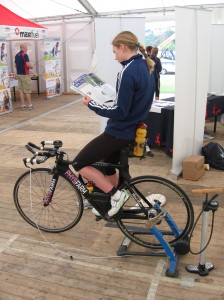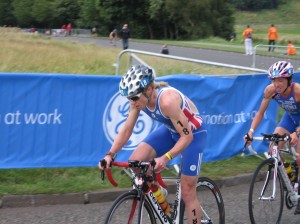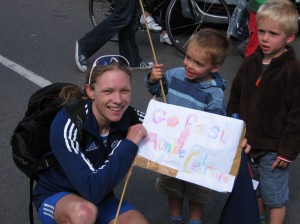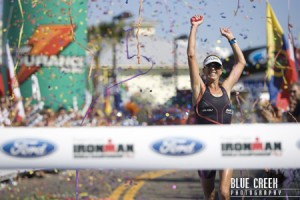Several years ago, Cat’s dad and I were chatting in Clearwater. He was marveling at the sunshine. “Scotland can be wet, windy, rainy and miserable.” he said in his thick Glaswegian accent, slapping me heartily on the shoulder, “And that is on a good day!”
Catriona Morrison trains irrespective of all that. This is a good thing, because the night before the 2010 Duathlon World Championships, the forecast was for broken clouds, scattered showers and heavy winds. It would be worse at the top of Arthur’s seat, the big climb the athletes would race up seven times.
The rain stayed clear, but it was blowing a gale come morning. We set Cat up in one of the race tents for a warm up. Athletes from the world over buzzed about nervously outside. Cat was her usual self. Richard and I put her on the bike and set about bringing some bags over to transition.
I knew Cat was physiologically prepared. We’d spent the past 4 weeks in a Duathlon-specific, course specific training regime, and it had gone very well. She was as fast as ever, but more importantly, she was healthy. We’d spent the winter and spring carefully rehabilitating the niggles from the season before, and we’d adjusted the training program to ensure they would not return.
In the back of my mind, I was a little concerned regarding the weight of expectation she was feeling. Cat was a multiple world-champion, representing her home country, racing in her home city, after a couple of years spent as the public face of the event in the media. Her cheerful smile was everywhere: billboards, race programs, signage galore. To some extent, this race wasn’t just about her success, but about representing the hopes of the people of her homeland in a very real way.
If Catriona was having any last minute anxiety, she didn’t show it. We returned to find her reading in the saddle, cool as a cucumber. She was ready.
When the gun went off, Cat was right down to business. One of the girls tried to get away in the opening kilometer, and Cat sat comfortably in the chase pack. She’d raced enough of these to know that the first run doesn’t have much to do with the way things shook out in the end. There were bigger fish to fry, like the climb up Arthur’s Seat that needed to be repeated seven times over. This is where we would make the move that would either win the race, or reveal some very strong competition.
On the first lap of the bike, Cat sat in, getting her legs under her and feeling out the competition, but by lap two Cat had moved to the front. Richard and I and most of the family had hurried halfway up the climb to a traffic circle to get a good eyeball on things, and were there in time to see Cat attack. On the steepest part of the climb, she gave it a little bit of gas, and revealed just how close to the limit her competitors were. There was carnage in her wake. Within just another lap, the rest of the field had fallen away into small groups and Cat was left with only Levenez (FRA) on her wheel.
By the time the second run started, Cat and her lone competitor had several minutes on the rest of the field. She’d forced Levenez to pull for the last two laps, which ensured a little bit of freshness for the run. As I saw them come past in the first kilometer of the run, Cat had already taken an 11 second lead. Walking back to the finish chute, I was just remarking to Richard how rare it is that an athlete is able to execute a race strategy so perfectly when news came from above. Cat had gotten a penalty!
Apparently, Cat had committed some sort of helmet violation in transition, and the referees gave her a stand down at the top of the hill on the first lap of the run. My jaw clenched. How much time? What kind of lead would Levenez get? We let out a collective sigh of relief as Cat came back down, having already passed Levenez again and extending her lead with every stride.Penalty or not, this race belonged to Catriona Morrison.
Cat hit the tape with a comfortable margin of victory, and I will never forget the roar of the home crowd as the Scots cheered home one of their own.
Seeing Cat smile, and her folks’ eyes well up as the flag was hoisted and the national anthem played, I silently congratulated her on a job well done. This scene is played over and over in athletic competition, and is among the most inspiring things we witness. For me, though, I would have to say that one of the most inspiring moments I’ve ever seen in sport came on lap 2 of the bike course.
I was standing behind the barricades, and two little girls, perhaps 5 and 3 years old, squeezed in front of me. The elder nudged the younger and pointed, “See her on the front? That’s Cat. She’s from here and she’s the best in the whole world!”
The younger cheered and waved her little flag. “Really?!” She asked.
“Yep.” She said, “I’m gonna do this next year.”
I wish Catriona could have been there to hear that.
